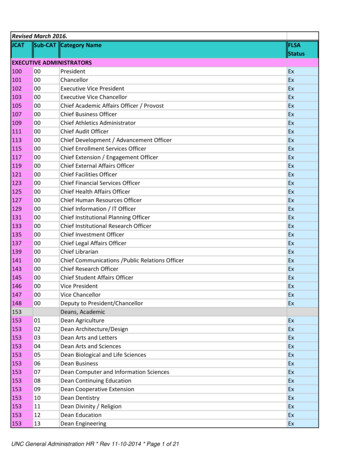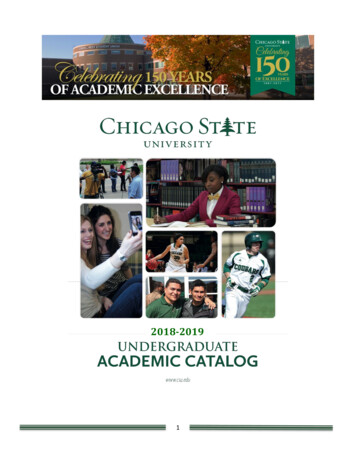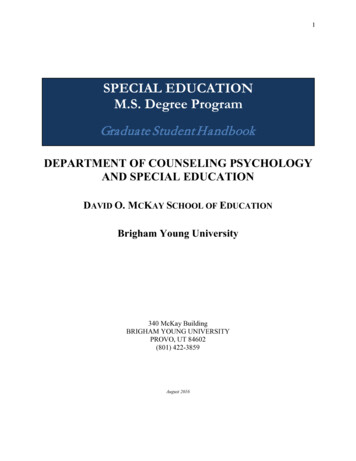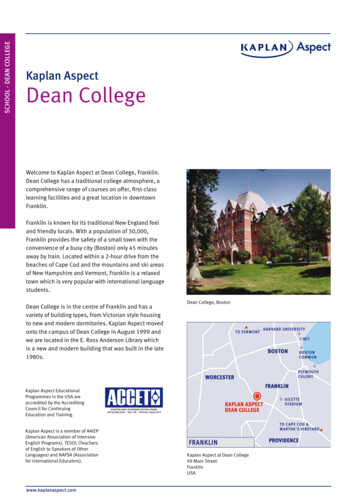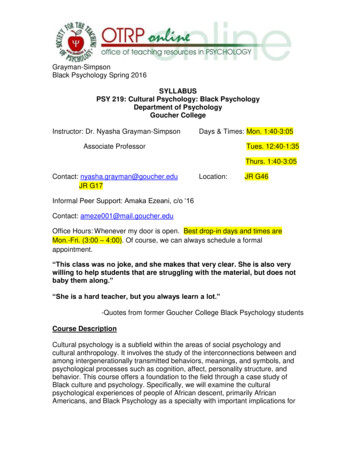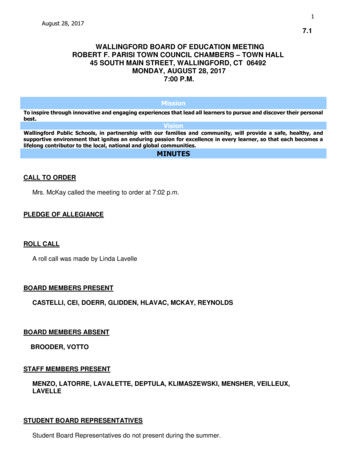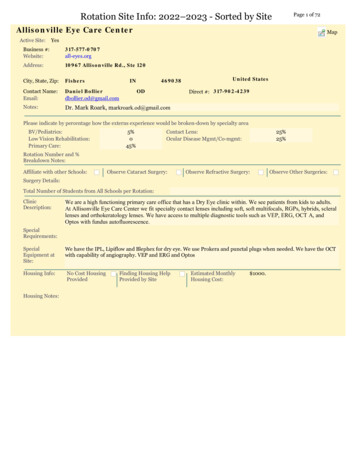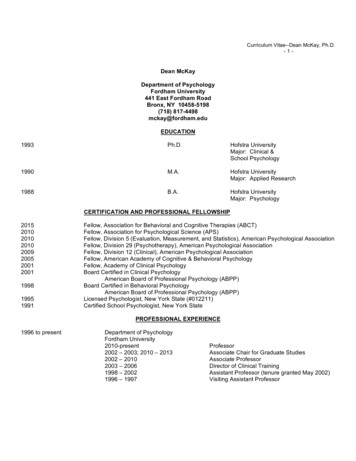
Transcription
Curriculum Vitae--Dean McKay, Ph.D.-1-Dean McKayDepartment of PsychologyFordham University441 East Fordham RoadBronx, NY 10458-5198(718) 817-4498mckay@fordham.eduEDUCATION1993Ph.D.Hofstra UniversityMajor: Clinical &School Psychology1990M.A.Hofstra UniversityMajor: Applied Research1988B.A.Hofstra UniversityMajor: PsychologyCERTIFICATION AND PROFESSIONAL 1991Fellow, Association for Behavioral and Cognitive Therapies (ABCT)Fellow, Association for Psychological Science (APS)Fellow, Division 5 (Evaluation, Measurement, and Statistics), American Psychological AssociationFellow, Division 29 (Psychotherapy), American Psychological AssociationFellow, Division 12 (Clinical), American Psychological AssociationFellow, American Academy of Cognitive & Behavioral PsychologyFellow, Academy of Clinical PsychologyBoard Certified in Clinical PsychologyAmerican Board of Professional Psychology (ABPP)Board Certified in Behavioral PsychologyAmerican Board of Professional Psychology (ABPP)Licensed Psychologist, New York State (#012211)Certified School Psychologist, New York StatePROFESSIONAL EXPERIENCE1996 to presentDepartment of PsychologyFordham University2010-present2002 – 2003; 2010 – 20132002 – 20102003 – 20061998 – 20021996 – 1997ProfessorAssociate Chair for Graduate StudiesAssociate ProfessorDirector of Clinical TrainingAssistant Professor (tenure granted May 2002)Visiting Assistant Professor
Curriculum Vitae--Dean McKay, Ph.D.-2-2010 - presentAdjunct ProfessorDepartment of PsychiatryMount Sinai School of MedicineInvestigator and Co-Investigator on grant funded research investigating basic features ofobsessive-compulsive and related disorders, across all ages.1998-PresentFounder and Co-Director, Institute for Cognitive Behavior Therapy and ResearchWhite Plains, New YorkTreatment and research center focused upon anxiety and related conditions. Conductdirect service treatment delivery and supervise trainees.1995-2000Clinical PsychologistLong Island Psychological Associates1995-1996Assistant ProfessorDepartment of PsychiatryMount Sinai School of MedicineSenior PsychologistElmhurst Hospital Center1991-1995Psychology Intern/Extern, Staff Psychologist & Research FellowInstitute for Bio-Behavioral Therapy and ResearchIntern/Extern period from 6/91 to 5/93.1990-1994Adjunct Instructor/ProfessorDepartment of PsychologyHofstra UniversityTaught Statistics, Research Methodology, Personality Theory, and DevelopmentalSeminar courses to undergraduates.1990-1991School Psychology InternRockville Centre School District1990-1991Psychiatric ExternCreedmoor Psychiatric CenterBehavioral Research Unit1989-1990Teaching AssistantDepartment of PsychologyHofstra University1989Research AnalystNassau/Suffolk Health Systems AgencyINVITED APPOINTMENTS2007Visiting ProfessorUniversidad Catolica de UruguayOctober 20-26
Curriculum Vitae--Dean McKay, Ph.D.-3-2018ELECTED POSITIONSPresidentBoard of DirectorsSociety for a Science of Clinical Psychology2017President-electBoard of DirectorsSociety for a Science of Clinical Psychology2017-2019Secretary-TreasurerCoalition for the Advancement and Application of Psychological Science (CAAPS)2014-2015Immediate Past PresidentBoard of DirectorsAssociation for Behavioral and Cognitive Therapies2013-2014PresidentBoard of DirectorsAssociation for Behavioral and Cognitive Therapies2012-2013President-electBoard of DirectorsAssociation for Behavioral and Cognitive Therapies2012-presentScientific CouncilAnxiety and Depression Association of America2012-2015Board of DirectorsAmerican Board of Cognitive & Behavioral Psychology2010-presentScientific Advisory BoardInternational Obsessive Compulsive Disorder Foundation2009-2012Representative-at-LargeBoard of DirectorsAssociation for Behavioral and Cognitive Therapies (ABCT)PROFESSIONAL COMMITTEESMember – Advisory Committee for the Development of a Qualified Clinical Data Registry (2017-present)Member – Media Expert Panel, Coalition of the Advancement and Application of Psychological Science (CAAPS) (2017present)Chair – Panic Disorder Practice Guidelines Committee (ADAA) (2015)Committee on Clinical Science Education and Advocacy, Society for a Science of Clinical Psychology (2014-present)Committee on Public Education and Media, Society for a Science of Clinical Psychology (2014-present; Committee chair2016-present)Panel on Emergency Care for Panic Disorder (through University of Melbourne, Australia)(2007-2009)Program Chair, Association for Behavioral and Cognitive Therapies (2007 conference, Philadelphia, PA)Associate Program Chair, Association for Behavioral and Cognitive Therapies (2006 conference, Chicago, IL)Health Anxiety Working Group (Founded 2006; Committee Member)(2006-present)International Obsessive-Compulsive Beliefs Workgroup (Founded 1995; Committee Member) (1995-present)Program Committee, AABT Annual Convention (1996-1998; 2008-2009)Committee for Academic Training (AABT) (1996-2004)EDITORIAL BOARDS
Curriculum Vitae--Dean McKay, Ph.D.-4-Behavior Therapy (Associate Editor, 2017-present)Journal of Cognitive Psychotherapy (Editor-in-Chief, 2012-2016)(Associate Editor, 2008-2012)Journal of Obsessive-Compulsive & Related Disorders (Associate Editor, 2009 – present)Frontiers in Psychiatry & Psychology: Psychopathology (2016-present)International Journal of Clinical & Health Psychology (2015 – present)Psychiatry Research (2013-2017)Behavior Therapy (2013-2016)Behavior Modification (2009-present)Clinical Case Studies (2009-present)Behaviour Research and Therapy (2007-present)Journal of Anxiety Disorders (2003-present)Journal of Clinical Psychology (2002-2010)Journal of Experimental Psychopathology (2009-present)Psychological Assessment (2014-2015)Cognitive and Behavioral Practice (1997)PROFESSIONAL AFFILIATIONSAmerican Psychological AssociationAssociation for Psychological Science (Fellow)Anxiety and Depression Association of AmericaAssociation for Behavioral and Cognitive Therapies (formerly Association for Advancement of Behavior Therapy) (Fellow)Quantitative and Qualitative Methods (Division 5 of of American Psychological Association (Fellow))Society for Clinical Psychology (Division 12 Clinical of American Psychological Association (Fellow))Society of Clinical Child and Adolescent Psychology (Division 53 of American Psychological Association)International Obsessive-Compulsive Disorder Foundation (formerly Obsessive Compulsive Foundation)Society for a Science of Clinical Psychology (Section III of Division 12 of American Psychological Association)GRANTS AND CONTRACTS“The effectiveness of stakeholder-centered versus research-centric treatment for childhood anxiety.” Submitted to thePatient Centered Research Institute (PI: Dean McKay; Co-PIs: Amy Przeworski, Stephen Whiteside). Requested totalfunding: 4.6 Million.“Resting state neural circuitry in neuroticism following cognitive-behavioral treatment.” Summer 2017 Faculty Fellowship,joint appointment Fordham and Columbia Universities (Fordham – Columbia Research Fellow). (Funded: 5000.00).“Evaluation of Funding Trends in the National Institute of Mental Health” (2015-2016). Association for PsychologicalScience (PI: Dean McKay)(Funded: 3000.00); Supplemental grants, Association for Behavioral & Cognitive Therapies(Funded: 1000) and Society for a Science of Clinical Psychology (Funded: 500.00)“Experimental tests of Terror Management and Relational Frame Theories in Anxiety and Disgust” (2013-2014). FacultyResearch Grant. (funded: 6432.50)“Cognitive remediation augmented CBT for OCD” (2012) submitted to National Institutes of Mental Health. Total proposedcontract: 853,600 (PI: Dean McKay)(Multisite with University of South Florida, PI: Eric Storch)(currently being revised)“Neural correlates of emotional response inhibition in Obsessive-Compulsive Disorder” (2010) (PI: Heather Berlin, PhD,Mt. Sinai Medical School; Co-Investigator: Dean McKay). Contract awarded by the International Obsessive CompulsiveDisorder Foundation. Total contract: 44,842.“Heritability of Obsessive-Compulsive Symptoms.” (2007) Contract awarded by the Mental Health Initiative (MINT)Foundation. Total contract: 10,000. (PI: Dean McKay)(Faculty grant supplement awarded April 2007. Total supplement 6500).
Curriculum Vitae--Dean McKay, Ph.D.-5-“Cognitive processes in worry.” (2000). (PI: Dean McKay) Faculty development grant awarded by the Fordham UniversityGraduate School of Arts & Sciences. Total: 1850.PUBLICATIONSPeer Reviewed ArticlesTeachman, B., Prinstein, M., McKay, D., Barch, D., Hollon, S., & Chambless, D. (in press). How psychosocial researchcan help the National Institute of Mental Health achieve its grand challenge to reduce the burden of mentalillnesses and psychological disorders. American Psychologist.Cepeda, S.L., McKay, D., Schneider, S.C., La Buissonniere-Ariza, V., Egberts, J.T.N.E., McIngvale, E., Goodman, W.K.,& Storch, E.A. (in press). Politically focused intrusive thoughts and associated ritualistic behavior in a communitysample. Journal of Anxiety Disorders.Frank, B., & McKay, D. (in press). The Suitability of an Inhibitory Learning Approach in Exposure When Habituation Fails:A Clinical Application to Misophonia. Cognitive & Behavioral Practice.Ojserkis, R., McKay, D., & Lebeaut, A. (in press). Associations between mental contamination, disgust, and obsessivecompulsive symptoms in the context of trauma. Journal of Obsessive-Compulsive and Related Disorders.McKay, D., Kim, S.K., Mancusi, L., Storch, E.A., & Spankovich, C. (2018). Profile analysis of psychological symptomsassociated with misophonia: A community sample. Behavior Therapy, 49, 286-294.McKay, D. (2017). Presidential Address: Embracing the Repulsive: The Case for Disgust as a Functionally CentralEmotional State in the Theory, Practice, and Dissemination of Cognitive-Behavior Therapy. Behavior Therapy, 48,731-738.Frank, B., Jacobson, N.C., Hurley, L., & McKay, D. (2017). An integrated dynamic modeling of anxiety in accord withRDoC and learning theory. Journal of Anxiety Disorders, 51, 39-46.McKay, D., & Tolin, D.F. (2017). Empirically supported treatments and the Research Domain Criteria (RDoC). Journal ofAffective Disorders, 216, 78-88.Crowe, K., & McKay, D. (2017). Efficacy of cognitive-behavioral therapy for childhood anxiety and depression. Journal ofAnxiety Disorders, 49, 76-87.Borda, T., Neziroglu, F., Taboas, W., & McKay, D. (2017). Overvalued Ideation in Adolescents with ObsessiveCompulsive Disorder. Psychiatry Research, 255, 66-71.McKay, D. (2016). Cognitive-behavioral treatment of hoarding in youth: A case illustration. Journal of Clinical Psychology,72, 1209-1218.Crowe, K., & McKay, D. (2016). Mindfulness, obsessive-compulsive symptoms, and executive dysfunction. CognitiveTherapy & Research, 40, 627-644.Kim, S.K., McKay, D., Taylor, S., Tolin, D., Olatunji, B.O., Timpano, K., & Abramowitz, J.S. (2016). The structure ofobsessive-compulsive symptoms and beliefs: A correspondence and biplot analysis. Journal of AnxietyDisorders, 38, 79-87.McKay, D., Ojserkis, R., & Elhai, J. (2016). Shared cognitive features of posttraumatic and obsessive-compulsivesymptoms. Cognitive Therapy & Research, 40, 173-178.Tolin, D.F., McKay, D., Forman, E.M., Klonsky, E.D., Thombs, B.D. (2015). Empirically supported treatment:
Curriculum Vitae--Dean McKay, Ph.D.-6-Recommendations for a new model. Clinical Psychology: Science & Practice, 22, 317-338.Azar, M., Riehm, K., McKay, D., & Thombs, B.D. (2015). Transparency of outcome reporting and trial registration ofrandomized controlled trials published in the Journal of Consulting and Clinical Psychology. PLoS One, 10,e0142894Pilecki, B., Thoma, N., & McKay, D. (2015). Cognitive-behavioral and psychodynamic therapies: Points of intersectionand divergence. Psychodynamic Psychiatry 43, 463-490.Thoma, N., Pilecki , B., & McKay, D. (2015). Contemporary cognitive-behavior therapy: A review of theory, history, andevidence. Psychodynamic Psychiatry, 43, 423-462. (Designated “Best Article of the Year” in the journal);Translated to Italian and reprinted as “La terapia cognitive-comportamentale contemporanea: Teoria, storia edevidenze empiriche”. Psicoterapia e Scienze Umane, 1, 9-16McKay, D., Sookman, D., Neziroglu, F., Wilhelm, S., Stein, D., Kyrios, M., Mathews, K., & Veale, D. (2015). Efficacy ofcognitive-behavior therapy for obsessive-compulsive disorder. Psychiatry Research, 227, 104-113.Franklin, M.S., Dingfelder, H.E., Freeman, J.B., Ivarsson, T., Heyman, I., Sookman, D., McKay, D., Storch, E.A., & March,J. (2015). Cognitive behavioral therapy for pediatric Obsessive-Compulsive Disorder: Empirical review andclinical recommendations. Psychiatry Research, 227, 78-92.Taboas, W., Ojserkis, R., & McKay, D. (2015). Change in disgust reactions following cognitive-behavioral therapy forchildhood anxiety disorders. International Journal of Clinical and Health Psychology, 15, 1-7.Ojserkis, R., McKay, D., Badour, C., Feldner, M., Arocho, J., & Dutton, C. (2014). Comprehensive distancing as a novelapproach to reducing moral disgust, shame, and guilt in posttraumatic stress reactions. Behavior Modification, 38,801-836.Whiteside, S.P.H., McKay, D., De Nadai, A., Tiede, M.S., Ale, C.M., & Storch, E.S. (2014). A baseline controlledexamination of a 5-day intensive treatment for pediatric obsessive-compulsive disorder. Psychiatry Research,220, 441-446.Badour, C.L., Ojserkis, R., McKay, D., & Feldner, M.T. (2014). Disgust as a unique affective predictor of mentalcontamination following sexual trauma. Journal of Anxiety Disorders, 28, 704-711.Taylor, S., Conelea, C., McKay, D., Crowe, K., & Abramowitz, J.S. (2014). Sensory intolerance: Latent structure andpsychopathologic correlates. Comprehensive Psychiatry, 55, 1279-1284.Taylor, S., McKay, D., Miguel, E.C., Mathis, M.A., Andrade, C., Ahuja, N., Sookman, D., Kwon, J.S., Huh, M.J., Riemann,B.C., O’Connor, K., Hale, L.R., Abramowitz, J.S., Fontenelle, L.F., & Storch, E.A. (2014). Musical obsessions: Acomprehensive review of neglected clinical phenomena. Journal of Anxiety Disorders, 28, 580-589.McKay, D., Kim, S.K., Taylor, S., Abramowitz, J.S., Tolin, D., Coles, M., Timpano, K.R., & Olatunji, B. (2014). AnExamination of Obsessive-Compulsive Symptoms and Dimensions using Profile Analysis via MultidimensionalScaling (PAMS). Journal of Anxiety Disorders, 28, 352-357.Abramowitz, J.S., Fabricant, L.E., Taylor, S., Deacon, B.J., McKay, D., & Storch, E.A. (2014). The utility of analoguestudies for understanding obsessions and compulsions. Clinical Psychology Review, 34, 206-217.Taylor, S., McKay, D., Crowe, K.B., Abramowitz, J.S., Conelea, C., Calamari, J., & Sica, C. (2014). The sense ofincompleteness as a motivator of obsessive-compulsive symptoms: An empirical analysis of concepts andcorrelates. Behavior Therapy, 45, 254-262.McKay, D., & Storch, E. A. (2014). Introduction to the special issue: Treatment of childhood obsessive-compulsivedisorder. Clinical Case Studies, 13, 3-8.
Curriculum Vitae--Dean McKay, Ph.D.-7-Ojserkis, R., Morris, B., & McKay, D. (2014). Pediatric Obsessive-Compulsive Disorder: An illustration of intensivefamily-based treatment delivered via web camera. Clinical Case Studies, 13, 68-79.Shams, G., Esmaili, Y., Karamghadiri, N., Ebrahimhkani, N., Yousefi, Y., & McKay, D. (2014). Psychometric properties ofthe Persian language version of the Obsessive Beliefs Questionnaire (OBQ-44) in Iranian general population.Acta Medica Iranica, 52, 66-75.Gruner, P., & McKay, D. (2013). Differences in Performance on the Wisconsin Card Sorting Test (WCST) BetweenPatients with Tic Related OCD and Non-Tic Related OCD: A Preliminary Investigation. Journal of ObsessiveCompulsive and Related Disorders, 2, 444-447.Rosmarin, D., Green, D., Pirutinsky, S., & McKay, D. (2013). Attitudes towards spirituality/religion among members of theAssociation for Behavioral and Cognitive Therapies. Professional Psychology: Research and Practice, 44, 424433.Pilecki, B. & McKay, D. (2013). The theory-practice gap in cognitive-behavior therapy. Behavior Therapy, 44, 541-547.Brand, J., McKay, D., Wheaton, M.G., & Abramowitz, J.S. (2013). The Relationship between Obsessive CompulsiveBeliefs and Symptoms, Anxiety and Disgust Sensitivity, and Swine Flu Fears. Journal of Obsessive-CompulsiveRelated Disorders, 2, 200-206.McKay, D. & Whiteside, S. (2013). Introduction to the special issue: New methods in exposure therapies. BehaviorModification, 37, 163-169.Weiner, E., & McKay, D. (2013). A preliminary evaluation of repeated exposure for depersonalization and derealization.Behavior Modification, 37, 226-242.Neziroglu, F., Weissman, S.E., Allen, J., & McKay, D. (2012). Compulsive hoarders: How do they differ from individualswith Obsessive-Compulsive Disorder? Psychiatry Research, 200, 35-40.Brand, J., & McKay, D. (2012). Telehealth approaches to obsessive-compulsive related disorders. PsychotherapyResearch, 22, 306-316.Thoma, N.C., McKay, D., Gerber, A.J., Milrod, B.L., Edwards, A.R., & Kocsis, J.H. (2012). A quality-based review ofrandomized controlled trials of cognitive-behavioral therapy for depression: An assessment and meta-regression.American Journal of Psychiatry, 169, 22-30.Taylor, S., Abramowitz, J.S., & McKay, D. (2012). Non-adherence and non-response in the treatment of anxietydisorders. Journal of Anxiety Disorders, 26, 583-589.McKay, D., & Andover, M. (2012). Should non-suicidal self-injury be a putative obsessive-compulsive related disorder? Acritical appraisal. Behavior Modification, 36, 3-17.Olatunji, B. O., Ebesutani, C., Sawchuk, C., McKay, D., Lohr, J., & Kleinknecht, R. (2012). Development and initialvalidation of the Medical Fear Survey-Short Version. Assessment, 19, 318-336.Pilecki, B., & McKay, D. (2012). An experimental investigation of cognitive defusion. Psychological Record, 62, 19-40.Pilecki, B., Clegg, J.W., & McKay, D. (2011). The influence of corporate and political interests on models of illness in theevolution of DSM. European Psychiatry, 26, 194-200.Pilecki, B., Arentoft, A., & McKay, D. (2011). An evidence-based causal model of panic disorder. Journal of AnxietyDisorders, 25, 381-388.
Curriculum Vitae--Dean McKay, Ph.D.-8-Novara, C., Pastore, M., Ghisi, M., Sica, C., Sanavio, E., & McKay, D. (2011). Longitudinal aspects of obsessivecompulsive cognitions: A five year follow-up study. Journal of Behavior Therapy and Experimental Psychiatry, 42,317-324.Baptista, M.N., Magna, L.A., McKay, D., & Del-Porto, J.A. (2011). Assessment of obsessive beliefs: Obsessivecompulsive disorder compared to a medical sample. Journal of Behavior Therapy and Experimental Psychiatry,42, 1-5Olatunji, B.O., Moretz, M.W., Wolitzky-Taylor, K., McKay, D., McGrath, P.B., & Ciesielski, B.G. (2010). Disgustvulnerability and symptoms of contamination-based OCD: Descriptive tests of incremental specificity. BehaviorTherapy, 41, 475-490.Taylor, S., Coles, M.E., Abramowitz, J.S., Wu, K.D., Olatunji, B.O., Timpano, K.R., McKay, D., Kim, S.E., Carmin, C.,Tolin, D.F. (2010). How are dysfunctional beliefs related to obsessive-compulsive symptoms? Journal of CognitivePsychotherapy, 24, 165-176.Storch, E.A., & McKay, D. (2010). Introduction to the special issue: Recent developments in childhood obsessivecompulsive disorder. Child and Youth Care Forum, 39, 69-71.Storch, E.A., McKay, D., Reid, J.M., Geller, D., Goodman, W.K., & Murphy, T.K. (2010). D-cycloserine augmentation ofcognitive-behavioral therapy in pediatric obsessive-compulsive disorder: Rationale, design, and methods. Childand Youth Care Forum, 39, 101-112.McKay, D., & Olatunji, B.O. (2010). Disgust and psychopathology: Introduction to Part II of the Special Series.International Journal of Cognitive Therapy, 3, 1-2.Neziroglu, F., Hickey, M., & McKay, D. (2010). Psychophysiological and self-report components of disgust in bodydysmorphic disorder: The effects of repeated exposure. International Journal of Cognitive Therapy, 3, 40-51.Olatunji, B.O., Cisler, J., McKay, D., & Phillips, M.L. (2010). Is disgust associated with psychopathology? Emergingresearch in the anxiety disorders. Psychiatry Research, 175, 1-10.Markarian, Y., Larson, M.J., Aldea, M.A., Baldwin, S.A., Good, D., Berkeljon, A., Murphy, T.K., Storch, E.A., & McKay, D.(2010). Multiple pathways to functional impairment in obsessive-compulsive disorder. Clinical Psychology Review,30, 78-88.McKay, D., & Neziroglu, F. (2009). Methodological issues in the obsessive-compulsive spectrum. Psychiatry Research,170, 61-65.Abramowitz, J.S., Taylor, S., & McKay, D. (2009). Obsessive-compulsive disorder. Lancet, 374, 489-497.McKay, D., & Olatunji, B.O. (2009). Disgust and phobic avoidance: Introduction to part I of the special series.International Journal of Cognitive Therapy, 2, 1-3.Charash, M., & McKay, D. (2009). Disgust and contamination fear: Attention, memory, and judgment of stimulussituations. International Journal of Cognitive Therapy, 2, 53-65.Moretz, M.W., & McKay, D. (2009). The role of perfectionism in obsessive-compulsive symptoms: “Not just right”experiences and checking compulsions. Journal of Anxiety Disorders, 23, 640-644.Tryon, W.W., & McKay, D. (2009). Memory modification as an outcome variable in anxiety disorder treatment. Journal ofAnxiety Disorders, 23, 546-556.Olatunji, B.O., Moretz, M.W., McKay, D., Bjorklund, F., de Jong, P.J., Haidt, J., Hursti, T.J., Imada, S., Koller, S., Mancini,F., Page, A.C., Scheinle, A. (2009). Confirming the three-factor structure of the Disgust Scale-Revised in eight
Curriculum Vitae--Dean McKay, Ph.D.-9-countries. Journal of Cross-Cultural Psychology, 40, 234-255.McKay, D. & Moretz, M.W. (2008). Interoceptive cue exposure for depersonalization: A case series. Cognitive andBehavioral Practice, 15, 435-439.Olatunji, B.O., Haidt, J., McKay, D., & David, B. (2008). Core, animal reminder, and contamination disgust: Personality,behavioral, and physiological correlates and relation with specific anxiety disorder symptoms. Journal ofResearch in Personality, 42, 1243-1259.Moretz, M.W. & McKay, D. (2008). Disgust sensitivity as a predictor of obsessive-compulsive contamination symptomsand associated cognitions. Journal of Anxiety Disorders, 22, 707-715.McKay, D. & Bouman, T.K. (2008). Enhancing cognitive behavior therapy for Monosymptomatic hypochondriasis withmotivational interviewing: Three case illustrations. Journal of Cognitive Psychotherapy, 22, 154-166.Napolitano, L. & McKay, D. (2007). Dichotomous thinking in Borderline Personality Disorder. Cognitive Therapy andResearch, 31, 717-726.Olatunji, B.O., & McKay, D. (2006, Guest Editors). Further Exploration of the Role of Disgust Sensitivity in Anxiety andRelated Disorders. Anxiety, Stress, and Coping, 19, 331-334.Charash, M., McKay, D., & DiPaolo, N. (2006). Implicit attention bias for disgust. Anxiety, Stress, and Coping, 19, 353364.Olatunji, B., & McKay, D. (2006, Guest Editors). Introduction to the special series: Disgust sensitivity in anxietydisorders. Journal of Behavior Therapy and Experimental Psychiatry, 37, 1-3.McKay, D. (2006). Treating disgust reactions in contamination-based Obsessive-Compulsive Disorder. Journal ofBehavior Therapy and Experimental Psychiatry, 37, 53-59.Taylor, S., Abramowitz, J., McKay, D., Calamari, J., Sookman, D., Kyrios, M., Wilhelm, S., & Carmin, C. (2006). Dodysfunctional beliefs play a role in all types of Obsessive-Compulsive Disorder? Journal of Anxiety Disorders, 20,85-97.McKay, D., Piacentini, J., Greisberg, S., Graae, F., Jaffer, M., & Miller, J. (2006). The structure of childhood obsessionsand compulsions: Dimensions in an outpatient sample. Behaviour Research and Therapy, 44, 137-146.Taylor, S., McKay, D., & Abramowitz, J. (2005). Hierarchical structure of dysfunctional beliefs in Obsessive-CompulsiveDisorder. Cognitive Behaviour Therapy, 34, 216-228.Obsessive Compulsive Cognitions Working Group. (2005). Psychometric validation of the obsessive beliefs questionnaireand interpretation of intrusions inventory: Part 2. Factor analysis and testing of a brief version. BehaviourResearch and Therapy, 43, 1527-1542.McKay, D. & McKiernan, K. (2005). Information processing and cognitive behavior therapy for Obsessive-CompulsiveDisorder: Comorbidity of delusions, overvalued ideas, and schizophrenia. Cognitive and Behavioral Practice, 12,390-394.Abramowitz, J., McKay, D., & Taylor, S. (2005, Guest Editors). Introduction to the special section: Subtypes inObsessive-Compulsive Disorder. Behavior Therapy, 36, 367-369.Haslam, N., Williams, B.A., Kyrios, M., McKay, D., & Taylor, S. (2005). Subtyping Obsessive-Compulsive Disorder: Ataxometric analysis. Behavior Therapy, 36, 381-391.Sookman, D., Abramowitz, J.S., Calamari, J.E., Wilhelm, S., & McKay, D. (2005). Subtypes of Obsessive-Compulsive
Curriculum Vitae--Dean McKay, Ph.D.- 10 -Disorder: Implications for specialized cognitive behavior therapy. Behavior Therapy, 36, 393-400.McKay, D. & Tsao, S. (2005). A treatment most foul: Handling disgust in cognitive-behavior therapy. Journal ofCognitive Psychotherapy: An International Quarterly, 19, 355-367.Abramowitz, J., Taylor, S., & McKay, D. (2005). Potentials and Limitations of Cognitive Treatments for ObsessiveCompulsive Disorder. Cognitive Behaviour Therapy, 34, 140-147.Taylor, S., Abramowitz, J., & McKay, D. (2005). Are There Interactions Among Dysfunctional Beliefs In ObsessiveCompulsive Disorder? Cognitive Behaviour Therapy, 34, 89-98.McKay, D. (2005). Studies in cognitive processing during worry. Cognitive Therapy and Research, 29, 359-376.McKay, D., Abramowitz, J., Calamari, J., Kyrios, M., Radomsky, A., Sookman, D., Taylor, S., & Wilhelm, S. (2004). ACritical Evaluation of Obsessive-Compulsive Disorder Subtypes: Symptoms versus Mechanisms. ClinicalPsychology Review, 24, 283-313.McKay, D., Gavigan, C., & Kulchycky, S. (2004). Social skills and sex role functioning in Borderline Personality Disorder:The relationship to self-mutilating behavior. Cognitive Behaviour Therapy, 33, 27-35.Tsao, S. & McKay, D. (2004). Behavioral avoidance tests and disgust in contamination fear: Distinctions from traitanxiety. Behaviour Research and Therapy, 42, 207-216.Neziroglu, F., Pinto, A., Yaryura-Tobias, J.A., & McKay, D. (2004). Overvalued ideation as a predictor of fluvoxamineresponse in patients with obsessive compulsive disorder. Psychiatry Research, 125, 53-60.McKay, D., Piacentini, J., Greisberg, S., Graae, F., Jaffer, M., Miller, J. (2003). The children’s Yale-Brown ObsessiveCompulsive Scale (CY-BOCS): Item structure in an outpatient setting. Psychological Assessment, 15, 578-581.Greisberg, S. & McKay, D. (2003). Neuropsychology of Obsessive-Compulsive Disorder: A Review and TreatmentImplications. Clinical Psychology Review, 23, 95-117.Obsessive-compulsive cognitions workgroup (2003). Psychometric validation of the Obsessive Beliefs Questionnaire andInterpretations of Intrusions Inventory: Part I. Behaviour Research and Therapy, 41, 863-878.McKay, D. (2002, Guest Editor). Introduction to the special series: Disgust in anxiety disorders (Guest Editor). Journalof Anxiety Disorders, 16, 475-476.Charash, M. & McKay, D. (2002). Attention bias for disgust. Journal of Anxiety Disorders, 16, 529-541.McKay, D. & Greisberg, S. (2002). Specificity of measures of thought control. Journal of Psychology, 136, 149-160.Grunes, M.S., Neziroglu, F., & McKay, D. (2001). Family involvement in the behavioral treatment of ObsessiveCompulsive Disorder. Behavior Therapy, 32, 803-820.McKay, D. (2001). Identifying and treating Body Dysmorphic Disorder. Directions in Mental Health Counseling, 11, 8796.Neziroglu, F., Stevens, K.P., Yaryura-Tobias, J.A., & McKay, D. (2001). Predictive Validity of the Overvalued IdeasScale: Outcome in Obsessive-Compulsive and Body Dysmorphic Disorders. Behaviour Research andTherapy,39, 745-756.Mulligan, M.E. & McKay, D. (2001). Hyperventilation, anxiety sensitivity, and the expectations for alcohol use: Subjectiveand physiological reactivity to alcohol cues. Addictive Behaviors: An International Journal, 26, 375-383.
Curriculum Vitae--Dean McKay, Ph.D.- 11 -Neziroglu, F., Yaryura-Tobias, J.A., Walz, J., & McKay, D. (2000). The effect of fluvoxamine and behavior therapy forchildren and adolescents with obsessive-compulsive disorder. Journal of Child and AdolescentPsychopharmacology, 10, 295-306.Neziroglu, F., McKay, D., & Yaryura-Tobias, J.A. (2000). Overlapping and distinctive features of hypochondriasis andobsessive-compulsive disorder. Journal of Anxiety Disorders, 14, 603-614.Yaryura-Tobias, J.A., Todaro, J., Grunes, M.S., McKay, D., Stockman, R., & Neziroglu, F.A. (2000). Comorbidity vs.Insertion of Axis I Disorders in Obsessive-Compulsive Disorder. Journal of Anxiety Disorders, 14, 19-30.McKay, D., Danyko, S., & Kulchycky, S. (2000). Borderline personality disorder and obsessive-compulsive symptoms:Parasuicidal links. Journal of Personality Disorders, 14, 57-63.McKay, D. & Schare, M. (1999). The effects of alcohol and alcohol expectancies on subjective reports and physiologicalreactivity: A meta-analysis. Addictive Behaviors: An International Journal, 24, 633-647.McKay, D. (1999). Two year follow-up of behavioral treatment and maintenance for Body Dysmorphic Disorder.Behavior Modification, 23, 621-630.Neziroglu, F.A., McKay, D., Stevens, K.P., Yaryura-Tobias, J.A., & Todaro, J. (1999). The Overvalued Ideas Scale:Development, reliability, and validity. Behaviour Research and Therapy, 37, 881-902.McKay, D., Neziroglu, F., Stevens, K., & Yaryura-Tobias, J.A. (1998). The Yale-Brown Obsessive-Compulsive Scale:Further factor analytic findings. Journal of Psychopathology and Behavioral Assessment, 20, 367-376.Obsessive Compulsive Beliefs Workgroup. (1997). Cognitive assessment of obsessive compulsive disorder. BehaviourResearch and Therapy, 35, 667-681.McKay, D., Neziroglu, F., & Yaryura-Tobias, J.A. (1997). Comparison of clinical cha
Department of Psychology Fordham University 441 East Fordham Road Bronx, NY 10458-5198 (718) 817-4498 mckay@fordham.edu EDUCATION 1993 Ph.D. Hofstra University Major: Clinical & School Psychology 1990 M.A. Hofstra University Major: Applied Research 1988 B.A. Hofstra University .
